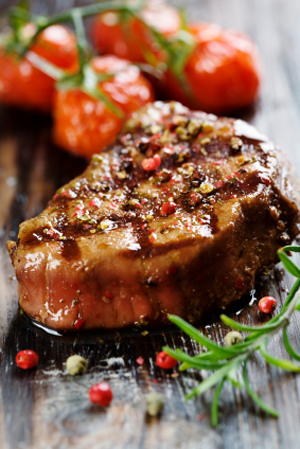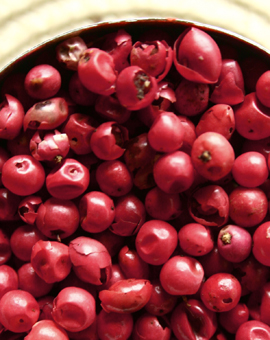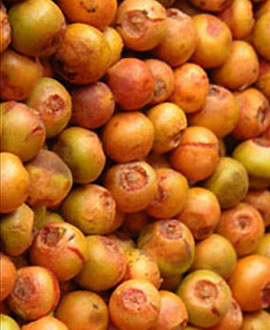 |


Even if they’re seasoning the food, scatter whole pink peppercorns and green peppercorns for a festive plate garnish. Photo by LivFriis-Larsen | IST. |
| WHAT IT IS: Varietal peppercorns—20 different pepper types and counting. |
WHY IT’S DIFFERENT: Each origin of the world produces pepper with different aromas and flavors—just like coffee beans and chocolate. |
| WHY WE LOVE IT: Another way to vary food accents—and it has no calories! |
| WHERE TO BUY IT: Pepper-Passion.com, Kalustyans.com. |
|
|
 |

Page 8: Pink Peppercorn & Other Pepper Types From
N To S
This is Page 8 of an 11-page article and pepper glossary. This page includes pink peppercorn, Szechuan pepper and other favorites. Jump to the glossary below. Click on the black links below to visit other pages.
INDEX
|
Varietal Pepper Glossary N To S
Pickled Pepper. The more fragile green and pink peppercorns are often pickled (packed in brine or vinegar) after picking. To everyone who ever wondered what exactly Peter Piper picked when he picked a peck of pickled peppers: It might have been eight quarts (a quarter-barrel) of peppercorns in brine. If so, it’s no surprise that people were wondering where the peck of pickled peppers was that Peter Piper picked, because it would have been worth quite a lot of money. Pickled peppercorns should be rinsed thoroughly before use.
Pink Peppercorn (Rose Pepper or Red Peppercorns). Pink peppercorns are often found for sale in mixes with black, white and green peppercorns, leading one to think that they’re a form of Piper nigrum—but they’re no relative of any kind. They’re berries from the Baies Rose Plant (Schinus molle, family Anacardiaceae), a small mastic tree related to the rose bush, from the French Island of Reunion in the Indian Ocean. The trees are often sprayed with PE3, a pesticide; but organic pink pepper is available.
The berries have a beautiful rose color and a delicate, fruity, slightly tart/citrus zest flavor with a mild pepperiness. Pink peppercorns became popular with the rise of nouvelle cuisine in the 1980s. They tend to be expensive, but you don’t need much to make an impression. They are also available pickled (rinse well before adding to food). They have a delicate bouquet and a sweet and spicy flavor, reminiscent of berries with undertones of citrus zest. Schinus molle is often confused with Schinus terebinthifolius, the Brazilian Pepper Tree, also called the Peruvian Pepper Plant and even the California Pepper Tree. It produces a very similar-looking berry that is red, rather than rose, in color.
Use In: Pink peppercorns go well in fruit sauces, vinaigrettes and desserts (sorbet and ice cream, puddings, baked goods) and are wonderful in vegetable, chicken and seafood dishes, especially in cream sauces. Chef Trosch uses them in omelet batters. From a visual perspective, a sprinkling of pink peppercorns makes any dish look more beautiful.
|
|

Pink peppercorns are berries from a small tree related to the rose bush. |
Piper nigrum. The botanical genus and species of the common black peppercorn, from the family Piperaceae. Black, green, red and white peppercorns are the fruit of the Piper nigrum vine.
Red Peppercorn. Many recipes calling for “Red Peppercorns” are actually referring to pink peppercorns (see above) or to red pepper, which refers to finely ground cayenne, a chile pepper. True red peppercorns are the fully ripe fruit of the Piper nigrum vine (see above), left on the vine until the berries mature, when they turn yellow with a red blush (like some pink grapefruit). Very few consumers have ever seen true red peppercorns, as they are very fragile. However, the sweetness and fruitiness they acquire as mature fruit, while retaining a milder peppery sizzle, make them an attractive product. As a result, they are available in very small quantity through specialty purveyors and have been championed by some leading chefs. The Poabs Organic Estate in Kerala, India has been producing organic red peppercorns since 2007 (available freeze-dried and sold under the Barts Spices brand, which is carried in the U.S. by Chelsea Market Baskets), and at Le Sanctuaire in San Francisco. |
|

Red peppercorns from PoabsOrganic.com. |
Sansho. Often confused with Szechuan pepper from China, sansho is the Japanese version of the berry from the same species of tree (the prickly ash). The difference is that sansho is the green berry, not the ripened berry used in China. Sansho is usually sold ground. Both sansho have tongue-tingling (and mouth-numbing) qualities, but those who use both find the green berries even more potent. The same tree yields the kinome leaves that are used as a garnish.
Sarawak. See Black Peppercorns and White Peppercorns.
Szechuan Peppercorn (or Chinese Pepper, Japanese Pepper, Prickly Ash, Sichuan Pepper and Szechwan Pepper). These are berries from a prickly ash tree (Zanthoxylum piperitum of the family Rutaceae) that is native to the Szechuan province of China. It is a small tree, or large thorny shrub, that is similar in appearance to ash trees, but unrelated: The plant is in the Rue, or citrus, family. Prickly Ash, also known as fagara, grows mainly in China, Japan and Korea. The tree’s rust-colored berries have hair-thin stems and open ends that split apart when dry to reveal a brittle black seed. The spice consists mainly of the empty husks, which have a different flavor from the seeds. Szechuan pepper is stronger and more pungent than most black pepper, with a peppery bouquet and a woodsy (some find anise, clove, cumin, ginger and lavender, based on provenance) and resinous flavor, moderate heat and a long finish. The berries are a key ingredient in many Chinese and Japanese dishes. The peppercorns are often lightly roasted before crushing in a mortar and pestle. Szechuan peppercorns are an ingredient in Chinese Five Spice Powder, Shichimi Togarashi (Japanese 7-spice powder, a blend that typically includes ginger, red pepper, roasted orange peel, the peppercorns, yellow and black sesame seeds, and seaweed), and and Szechuan Peppered Salt, a combination of toasted and finely ground peppercorns and sea salt. It is usually used to flavor soups or noodles as well as yakitori. For years there was an FDA ban on the import of Szechuan pepper because of a concern that it might bring new strains of citrus cankers to the U.S. to threaten domestic citrus crops; the problem was solved by heat-treating the pepper before export, and the ban was lifted in 2005. Szechuan pepper will leave the palate tingling: The berry contains numbing compounds that are used medicinally as a local anesthetic.
Use It: With fish and poultry, in soups and stews, in any dish where spicy heat is desired, and of course, with Asian cooking.
Continue To Page 9: Peppercorn Glossary T To Z
Go To The Article Index Above
Do you have friends who would enjoy THE NIBBLE?
Click here to send them an invitation to sign up for their own copy. |
ABOUT THE NIBBLE. THE NIBBLE™, Great Food Finds™, is an online magazine about specialty foods and the gourmet life. It is the only consumer publication and website that focuses on reviewing the best specialty foods and beverages, in every category. The magazine also covers tabletop items, gourmet housewares, and other areas of interest to people who love fine food.
© Copyright 2004-2025
Lifestyle Direct, Inc. All rights
reserved. All information contained herein is subject to change at any time
without notice. All details must be directly confirmed with manufacturers, service
establishments and other third parties. This material may not
be reproduced, distributed, transmitted, cached, or otherwise used, except with
the prior written permission of Lifestyle Direct, Inc.
|
 |
|
 |







